
Sure, there’s something incredibly satisfying about throwing big chips of wood as you slice effortlessly through an oak log. But, satisfaction isn’t the only reason to keep a chainsaw’s chain sharp. A sharp chain is also safer and helps prolong the life of the chainsaw and its bar. In most cases, a dull chain can be restored in short order, with the help of a chainsaw sharpener.
Despite the plethora of chain-sharpening options on the market, choosing the best chainsaw sharpener doesn’t have to be rocket science. This guide will explore what you need to know when choosing one of these handy tools for your saw.
Our Top Picks
Also In This Article
How We Picked the Best Chainsaw Sharpeners
There are a lot of different types of chainsaw sharpeners from a wide range of brands and makers. We know having so many options can be confusing, so we set out to ensure the models we suggested were up to the task.
We called upon our years of chainsaw work and woodcutting to pick out the features we felt were most important in a chainsaw sharpener. We looked for convenient power sources, portability, simple setups, adjustability, and other features that would make sharpening a wide range of chains straightforward.
Once we came up with sharpeners that met our criteria and came from brands we know and trust, we started comparing them. We compared how they worked, their convenience, how universal they were, and customer reviews and complaints among other factors.
Sharpeners that didn’t provide enough value were discarded as we felt the average user could find something that performed better for less money. The ones that met all our needs and criteria and provided the value we were looking for were given awards on our list.
Best Overall Chainsaw Sharpener
Oregon Compact 120V Universal Saw Chain Sharpener 310-120
DIYers and pros who want a sharpener that combines a great price with plenty of capability should consider the Oregon Compact 120-Volt Mini Bench Chain Sharpener. This model features a universal design that allows it to sharpen chains up to .404-inch pitch, making it a great solution for most home workshops.
This bench sharpener from Oregon features a compact design that doesn’t take up a lot of space on a workbench. However, it doesn’t have a clamping system to quickly attach it to the bench, so it does require two bolts to install and remove it. While that’s typical for most benchtop grinders, that could be a major improvement for a mini model like this one.
The 310-120 is easy to use. The user simply places the chain in the guide and clamps it in place. All that’s required is adjusting the base to the correct angle and adjusting the depth of the cut. The angle of the grinding wheel doesn’t adjust, allowing users to get to work right away, sharpening teeth and adjusting depth gauges.
Features
- Type: Bench Mount
- Power Source: Electric
- Chain Compatibility: Universal up to .404 pitch
Pros
- Compact design secures to a bench for stability and convenience but can be removed and stored away
- Universal design sharpens blades up to .404 pitch but also grinds depth gauges to size
- Straightforward design is free of complicated adjustments for beginner woodcutters
Cons
- It needs to be bolted to the work surface (but that is typical)
Price: $99.99
Best Manual Chainsaw Sharpener
Oregon Universal Chainsaw Field 7pc Sharpening Kit 617067
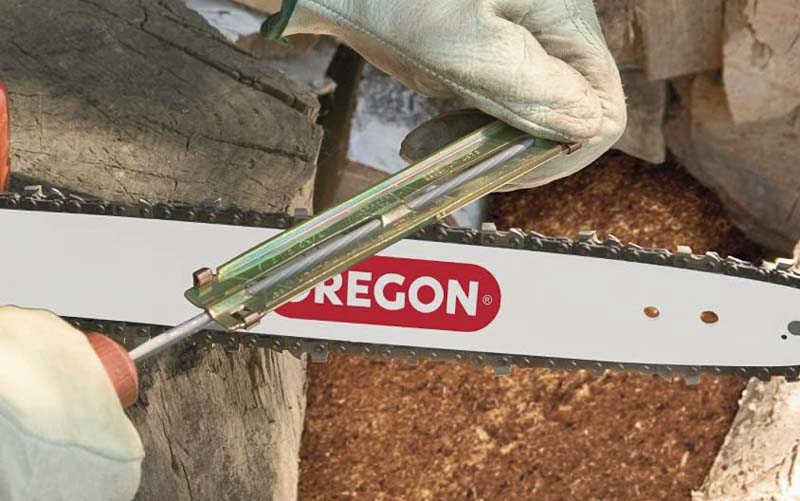
For those who don’t mind spending time fine-tuning their chainsaw’s teeth by hand, the Oregon Universal Chainsaw Field Sharpening Kit is the way to go. This kit comes with all of the tools required to sharpen just about any chain, including 5/32, 3/16, and 7/32-inch round files, a flat file for depth gauges, a file guide for accurate sharpening, and a depth gauge guide. It also comes with a wooden handle for the files and a pouch to keep things in place for transport.
As with most manual sharpeners, it will take a while to sharpen a very dull chain with this kit. However, the compact pouch makes it extremely easy to transport and keep in a truck or toolbox, so it’s always conveniently on hand no matter where the job is. And, since the chain doesn’t need to be removed from the bar to sharpen it, it provides an easy fix for quickly maintaining teeth.
Features
- Type: Portable
- Power Source: Manual
- Chain Compatibility: Universal
Pros
- Comes with several different files for sharpening almost any chain
- Compact storage pouch keeps everything secure and makes this kit highly portable
- Comes with an angle gauge and depth gauge guides for accuracy
- The chain does not have to be removed from the bar to be sharpened
Cons
- Takes a while to repair severely dulled chains
Price: ~ $20
Best Electric Chainsaw Sharpener
Oregon 12V Sure Sharp Handheld Grinder/Sharpener 575214
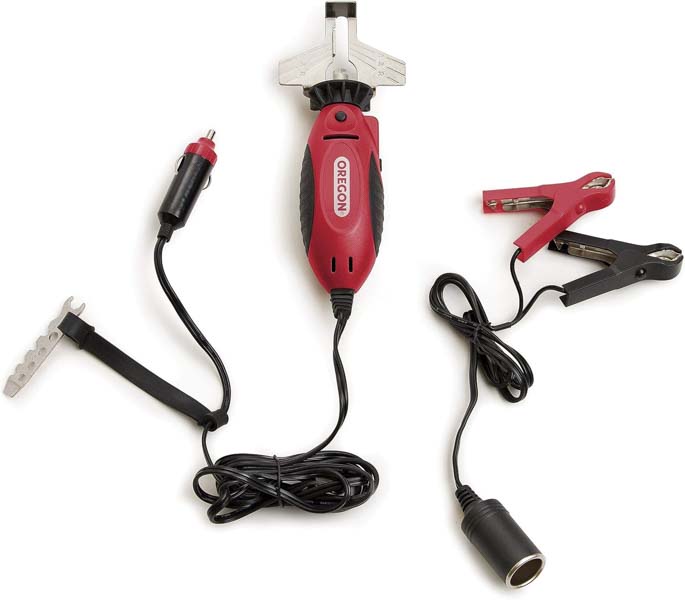
Oregon’s 575214 Handheld Electric Chainsaw Grinder/Sharpener is our choice for the best electric chainsaw sharpener. This compact tool features an electric motor that runs on a vehicle’s 12-volt battery system, ensuring users can sharpen their chains whenever needed. It has a clip system that attaches directly to the battery or a power adapter that plugs into the vehicle’s console or 12-volt port.
This model comes with several grinding stones, including 5/32, 3/16, and 7/32-inch. It also has a built-in angle gauge for accurate sharpening, allowing the user to clean up their chain’s teeth without removing it from the bar. Unfortunately, it doesn’t grind depth gauges or come with a carrying case, but the compact design makes it easy to store in a vehicle.
Features
- Type: Handheld
- Power Source: Electric
- Chain Compatibility: ¼, ⅜ LP, .325, ⅜, and .404-inch
Pros
- Flexible power options ensure it can quickly sharpen a blade
- Comes with multiple grinding stones and a built-in angle gauge for accurate grinding
- Compact design is easy to store in a toolbox or under a truck seat
- It can sharpen the chain while it’s still installed on the bar
Cons
- It doesn’t sharpen depth gauges so users will need a separate tool for that
- It doesn’t come with a case other than the plastic blister pack it’s packaged in
Price: $39.87
Best Professional Chainsaw Sharpener
Tecomec Super Jolly Bench Mounted Chain Grinder 11509006
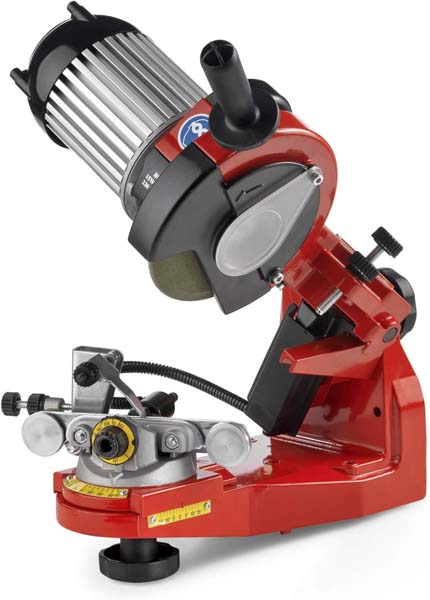
Whether you make your money grinding chains or you simply want the tools the pros use, the Tecomec Super Jolly Bench Mounted Chain Grinder is a great fit. This model features a wide range of adjustability, including the miter angle, the down angle, the tilt, the top late angle, and the depth stop. Users can quickly and easily clean up their existing cutting edges and depth gauges and adjust their down-angle to create more aggressive chains or those requiring less frequent sharpening.
This pro-grade model has some other features worth considering. It can mount to a bench with two bolts or to a wall for convenience. It also features a built-in light and a hydraulic clamp that makes clamping the chain easy and secure. But these features do come at a premium price—it’s the most expensive model on the list.
Features
- Type: Bench Mount
- Power Source: Electric
- Chain Compatibility: Universal
Pros
- Features a wide range of adjustability, allowing it to sharpen any chain
- Mounts to a wall or bench for convenience and stability while grinding
- Down angle adjustment allows users to create sharper or more durable teeth, customizing their profile
- Semi-hydraulic chain clamp creates quick, easy, secure clamping pressure
Cons
- As a pro-grade piece, it’s much more expensive than most of the other models on the list
Price: ~ $390
Best Bench-Mounted Chainsaw Sharpener
Oregon Professional Compact 120-Volt Chainsaw Sharpener 410-120
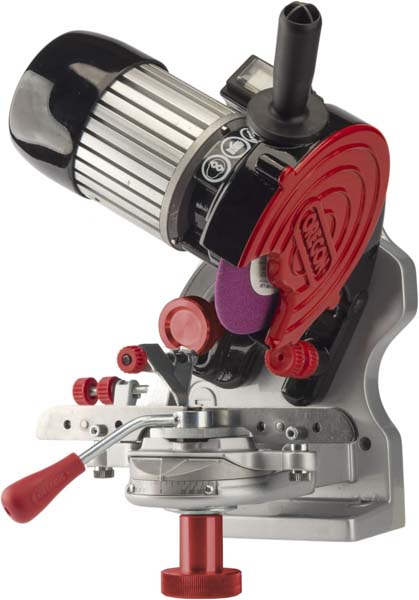
Woodcutters looking for the best chain sharpener they can mount to their bench without losing all their usable space should consider the Oregon Professional Compact Chainsaw Sharpener. This electric chainsaw grinder bolts to the workbench to provide stability and control when making adjustments and sharpening teeth. But, it’s small enough not to take up the entire bench.
Despite its relatively compact design, this model from Oregon features plenty of adjustments. It features an adjustable miter angle, down angle, and depth stop, allowing it to sharpen any chain up to .404 inches. It doesn’t have a hydraulic clamp, but they’re usually only available on much more expensive sharpeners.
Features
- Type: Bench Mount
- Power Source: Electric
- Chain Compatibility: Universal
Pros
- Mounts to a bench or a wall surface, making it a convenient option for crowded shops
- Universal design with a wide range of adjustments can sharpen any chain up to .404
- Compact design has all the adjustments of more expensive models in a smaller tool
Cons
- A hydraulic clamp would be a step up, but we’re getting picky
Price: ~ $230
Best Bar-Mounted Chainsaw Sharpener
Granberg International 12V Precision Grinder G1012XT
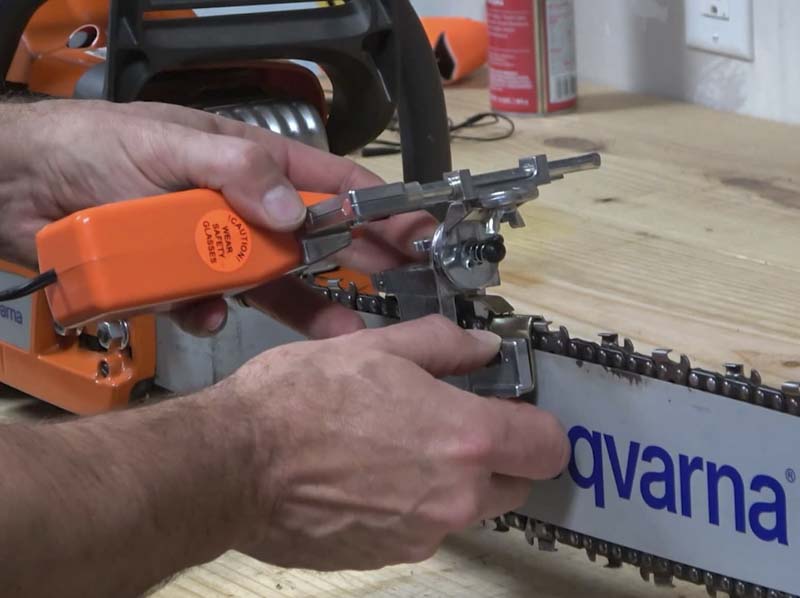
Granberg International’s bar-mounted Precision Grinder is a great choice for convenient off-grid sharpening. This tool easily mounts to bars and uses a vehicle’s 12-volt battery to power the electric grinder. The user simply attaches the grinder, sets the angle, and works the grinder across the teeth to sharpen them. It’s also capable of lowering depth gauges—a rare feat for small electric grinders.
Even though it’s relatively compact, the Granberg grinder is a heavy-duty tool. It’s capable of grinding chains on bars up to 54 inches in length. It comes with three grinding stones, including 5/32, 3/16, and 7/32 inches. It doesn’t have a 12-volt adapter, however, so users will need to purchase a separate power pack or always run it off their vehicle’s battery.
Features
- Type: Bar Mounted
- Power Source: Electric
- Chain Compatibility: Universal on bars up to 54 inches
Pros
- Run on a vehicle’s 12-volt electrical system for off-grid sharpening
- The heavy-duty tool is compatible with bars up to 54 inches in length
- Easily mounts to a bar and is compatible with all grinding stones for universal grinding
- It’s capable of lowering depth gauges as well
Cons
- It doesn’t have a 120-volt adapter
Price: $109
Best Dremel Kit for Chainsaw Sharpening
Dremel Sharpening Kit A679-02
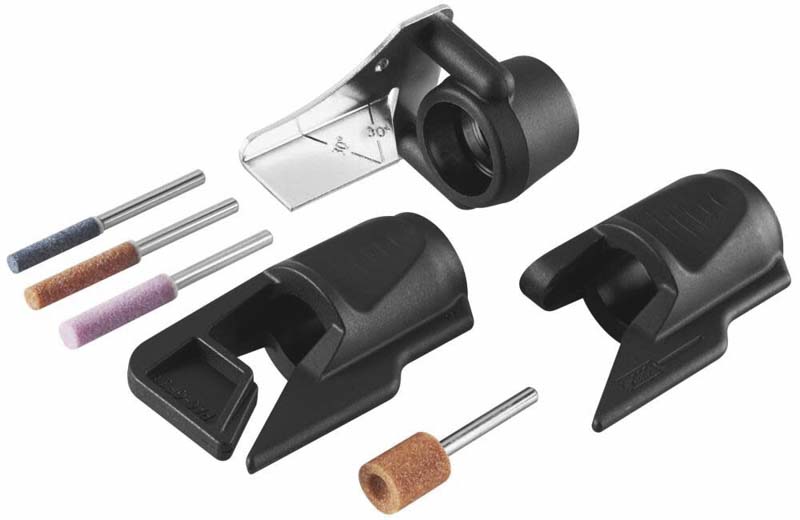
For those who’d rather turn their Dremel into a chainsaw sharpener than buy a whole new tool, this kit from the rotary tool brand is a great choice. This kit comes with multiple collars that easily attach to a Dremel, one of which has a built-in angle gauge to help users eyeball their chainsaw sharpening technique. It comes with three grinding stones meant for chainsaw chains as well as a standard grinding wheel for large garden tools.
We liked that this kit is compatible with a wide range of garden tools, as it makes a Dremel even more versatile. However, the angle gauge is relatively small so it could make sharpening accurately a bit more difficult than a dedicated grinder.
Features
- Type: Attachment
- Power Source: Dremel-based
- Chain Compatibility: Universal
Pros
- Kit turns a standard Dremel into a chainsaw sharpener for convenience
- Comes with a few different grinding stones to fit most chains
- Kit also works for sharpening garden tools
Cons
- The angle gauge is relatively small, making it hard to stay consistent and accurate
Price: $22.99
Best Chainsaw Sharpener Buying Guide
There are so many chainsaw sharpening tools available, so it can be tough to know what to look for. The following are some of the most important factors to consider when choosing a chainsaw sharpening tool.
Types of Chainsaw Sharpeners
Electric Chainsaw Sharpeners
Electric chainsaws are handy tools that make sharpening a chain a breeze. They’re typically either handheld or bench-mounted, and they come with a few different bit sizes to fit different chain pitches. They usually have guides attached that allow them to grind a perfect edge, and they’re especially helpful for very dull chains.
It’s important to note that some electric sharpeners can fix a chain while it’s still on the bar. Others, however, may require removing and feeding it through a guide in the sharpener to clean up the edges.
Manual Chainsaw Sharpeners
Manual chainsaw sharpeners require a bit of elbow grease, but they’re effective and quite helpful for maintaining an edge before it goes completely dull. The star of the show is the file, which is round and designed to grind the chain’s teeth sharp again. If the chain isn’t too far gone, manual sharpening should only take a few minutes.
Portable Chainsaw Sharpeners
Portable chainsaw sharpeners come in handy when felling trees or cleaning up a site away from the garage. If the bar accidentally dips into the ground or hits something embedded in the tree, a portable sharpener can bring the chain back up to snuff. There are several types, including electric ones that plug into car charging ports or clip onto battery terminals as well as manual models.
Sharpening Angle and Depth
Chainsaw teeth have specific angles from the factory, allowing them to cut efficiently in concert with the other teeth. Those skilled in hand sharpening can usually follow the angle reasonably well, but for newer chainsaw handlers, it’s best to find a sharpener with an adjustable guide. Typical sharpener guides range between 25 and 35 degrees.
It’s also necessary to ensure that the depth gauges, or rakers, are set slightly below the height of the cutting edges. These small projections control how deeply into the wood the chain will cut, and if they’re too high, they’ll prevent the chain from biting into the wood. Some 2-in-1 tools will sharpen the cutting edges and file the raker at the same time, while others come with a gauge that sits overtop of the raker and helps the user guide a flat file over top to the correct depth.
Another factor to consider is the depth of the gullet. This is the valley or low point that precedes the cutting edge, and its job is to promote the correct chip size, cool the chain, and promote lubrication flow along the chain while cutting. Gullets typically increase in size due to repeated sharpening.
Compatibility with Chainsaw Models and Bars
Most chainsaw sharpeners are relatively universal when it comes to brands and models. A sharpener that works for a Husqvarna will likely work for a Stihl or an Echo. The truth of the matter is that most of these saws use non-brand-specific chains, and Oregon is the leading manufacturer. Users can swap out their current chains for new ones, which many do when they purchase a new saw with a low-kickback blade.
When it comes to sharpening different chain pitches, compatibility comes down to the files or bits included in the kit. Common chain sizes include .325, .404, 1/4 P, ¼, 3/8 P, and ⅜, and most kits come with files or grinding stones that measure 5/32, 3/16, or 7/32 inches in diameter. These will cover the most common chain types, depending on the angle required for the teeth. Kits typically come with a flat file for lowering the depth gauges as well.
Price Range and Budget
Price range is one of the most important factors when choosing the best chainsaw sharpener. Some models cost less than $20, but they’re typically manual and require a bit more time to sharpen a dull chain. Most expensive models may cost $200 or more, but they can make quick work of an extremely dull chain.
Uses of Chainsaw Sharpeners
As mentioned earlier, chainsaw sharpeners might only help grind teeth on a chain, but there are a lot of reasons to do so. Here are the most important reasons to use a chainsaw sharpener.
Maintaining Sharp Chains for Efficient Cutting
Keeping the teeth on a chainsaw sharp allows it to cut quickly and efficiently. As the saw runs, it will expel large wood chips, allowing teeth to keep cutting and avoiding clogging. Also, sharp teeth can cut through hardwoods faster, requiring less time, less gas, and less bar lubricant.
Extending the Lifespan of Your Chainsaw
A sharp chain cuts through hardwood faster and more efficiently. This allows the chainsaw, the bar, and its chain to run cooler, extending their lives. Also, since the chainsaw can cut in less time, it will accumulate fewer hours to cut the same amount of wood as a saw with a dull chain, reducing wear and tear and extending the life of the machine.
Safety Benefits of a Sharp Chainsaw
The old adage about a sharp blade being a safe blade applies to chainsaw chains, too. Dull chains require more effort from the users and can be more difficult to control, sometimes skipping or kicking as they cut. This is particularly dangerous when undercutting a fallen log, as the tip of the bar contacting the wood can kick the bar back at the user. A sharper chain is less likely to cause kickback.
Professional and DIY Applications
Whether you’re a pro maintaining a fleet of chainsaws and pole saws or a DIYer who rarely uses their one saw, chainsaw sharpeners are important. These tools ensure the cutting edges are always sharp, allowing saws to run more efficiently and safely. Sharpening helps protect the user and their investment.
Protective Gear and Clothing
You don’t have to don chaps and a hard hat, but you might consider a few items of personal protective equipment. For instance, a good set of gloves is important, particularly when manually sharpening. Gloves can protect you from getting nicked if your hand slips.
Also, consider eye protection to prevent any small slivers or shavings from potentially making their way into your eyes. If you’re using an electric sharpener, be sure to wear hearing protection along with your glove and eye protection.
Proper Workspace Setup
Give yourself enough space to get the job done, as well. Consider moving other items on the bench away from the work area, allowing you to either set the chainsaw firmly in place or securely attach the sharpener to the bench surface (depending on the type of sharpener chosen). It’s also important to have plenty of light available so you’ll be able to see the teeth you’re sharpening.
Operating the Sharpener Safely
Operating the sharpener safely is fairly straightforward. If you’re using a manual sharpener, simply slide the file across the cutting edge a few times without forcing it or moving too quickly. For electric sharpeners, make sure to follow the manufacturer’s instructions while also maintaining firm footing. Also, leave any guides or guards in place to prevent injuries or accidentally damaging the chain.
Storage and Maintenance of the Sharpener
Most chainsaw sharpeners come with a case or pouch to keep them safely stored away. But, before packing the chainsaw sharpener away, be sure to clean off any dust, dirt, grime, sap, or pitch from the tool. Use a brush to remove sawdust and chips, and clean off the resin or sap. Resin-removing solvents and sticks can help keep files operational for longer and make sharpening easier.
Frequently Asked Questions About Chainsaw Sharpeners
The following are some of the most frequently asked questions about chainsaw sharpeners, including the types of sharpeners and required frequency.
How Often Should I Sharpen My Chainsaw?
Old lumberjacks would often sharpen their chainsaws just about every day, after each use. However, if you’re only cutting a few times each year, plan to sharpen once a year or whenever the chips are noticeably smaller and the saw cuts slower.
Can I Sharpen My Chainsaw Chain by Hand?
Yes, there are manual sharpening systems that allow users to sharpen their chainsaw chains by hand. Experienced woodcutters can often sharpen their saws with just a file, but most sharpening sets come with guides to make the job easier.
What’s the Difference Between Electric and Manual Sharpeners?
Electric sharpeners use motors and spinning bits or wheels to remove metal from a cutting edge and restore the chain’s cutting potential. Manual sharpeners use files that the user guides across the cutting edge. Manual sharpeners are great for maintaining a cutting edge, while electric sharpeners are best for severely dull chains.
Do Chainsaw Sharpeners Work on All Chainsaw Brands?
Typically, yes. Chainsaw sharpeners are designed to work with specific chains, not brands. Since most brands use the same types of chains, chainsaw sharpeners are relatively universal. As long as they can sharpen a certain size of chain, it doesn’t matter what brand makes the saw.
What Are Some Common Chainsaw Sharpener Problems?
Many common chainsaw sharpener problems have more to do with the person using them than the tools themselves. The following are some common issues:
- Using the wrong file for the chain
- Oversharpening and enlarging the gullet
- Using too much force
- Not using the same number of strokes for each cutting-edge
- Not maintaining the proper angle when sharpening
- Not having the guide attached securely to the bar, or the chain fed properly through the sharpener
Why You Can Trust Pro Tool Reviews
Ever check out a “review” site and you can’t tell if the author has any real experience with tools or if they’re just “recommending” the Amazon top sellers? That’s not us. We won’t recommend anything unless we’d use it ourselves. It’s all about giving you a legitimate recommendation and our honest opinion of each product.
We’ve been in business since 2008 covering tools, writing reviews, and reporting on industry news in the construction and lawn care industries. Our Pro reviewers work in the trades and have the skills and experience to know whether tools can perform well in the field.
Each year, we bring in and review more than one hundred individual products. Our team will put our hands on hundreds more at media events and trade shows throughout the year.
Pro Tool Reviews consults with innovators in the technology and design of tools to gain a broader grasp of where these products fit and how they work.
We work with more than two dozen professional contractors nationwide who review products for us on real job sites. We consult with them extensively on testing methods, categories, and practical applications.
Our site will provide several hundred pieces of new content this year absolutely free for our readers. That includes objective evaluations of individual tools and products.
The result is information you can trust because of the editorial, scientific, and real-world professional experience we collectively utilize each and every time we pick up and test a tool.






